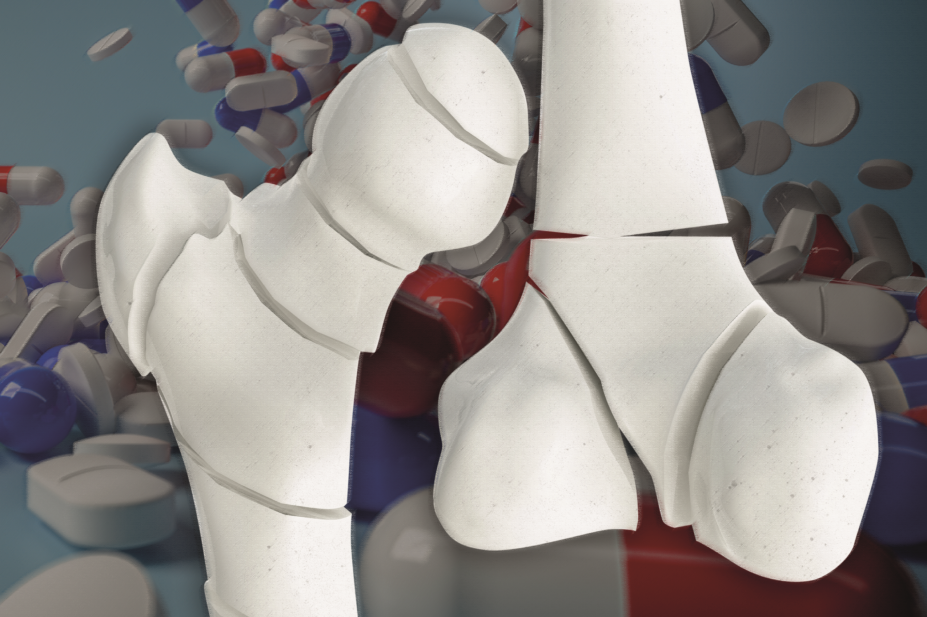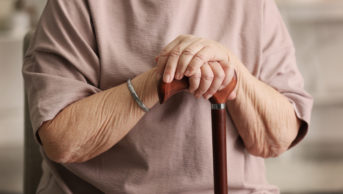
Shutterstock.com / MAG
Reports of rare side effects with commonly prescribed osteoporosis drugs have led to a growing a number of patients at risk of fractures refusing treatment. Some of these side effects include osteonecrosis of the jaw and atypical femoral fractures. In fact, use of the most commonly prescribed drugs fell by 50% from 2008 to 2012 in the United States, according to a research paper published in Journal of Bone and Mineral Research
[1]
, and physicians say that this trend is continuing[2]
.
Osteoporosis is a systemic skeletal disease characterised by low bone strength, leading to an increased risk of fracture. It is a major public health concern, affecting about 200 million people worldwide[3]
. A British study showed that about one in two women and one in five men over the age of 50 experience an osteoporotic fracture at some point in later life[4]
.
The consequences of osteoporotic fractures are serious, including disability, loss of independence, and death. After a hip fracture, 40% of patients cannot walk independently and 10–20% require permanent nursing home care[3]
. The economic burden is high, with healthcare costs of about €37bn per year in the EU and US$19bn per year in the United States[3]
.
There are excellent clinical tools for diagnosing osteoporosis and assessing fracture risk[5]
. Advances in understanding the pathophysiology of osteoporosis have led to the development of a broad range of medicines (eg, bisphosphonates, raloxifene, denosumab, strontium ranelate, teriparatide) that strengthen bone and reduce fracture risk[6]
. The cost of some of these, especially the oral bisphosphonates, is low. Clinical trials have shown that the balance of benefits and risks is highly favourable in appropriately selected patients. However, most patients who could benefit from treatment are not receiving it. Of those who are prescribed a medicine, some do not fill the prescription, do not take it regularly or correctly (proper administration is especially important with oral bisphosphonates because, if not taken properly, the drug’s efficacy could be reduced and unpleasant side effects may occur), or do not take it long enough to achieve the desired reduction of fracture risk[7]
. The net result is a large osteoporosis treatment gap, resulting in a high personal and economic burden from fractures that might have been prevented by treatment.
Treatment gap
There are a host of reasons for the widespread undertreatment of the disease, many of which centre on lack of resources. First, there is a lack of public health information on the condition and as drug patents expire, financing of public awareness campaigns of osteoporosis dwindles.
Second, there are few osteoporosis specialists with advanced levels of expertise in managing patients with osteoporosis and bone mineral density (BMD) testing by dual-energy X-ray absorptiometry (DXA) is not universally available or affordable.
Clinical practice guidelines for osteoporosis treatment are sometimes confusing or conflicting and physicians as well as patients may have a poor understanding of the balance of benefits and risks with osteoporosis treatment. Even when physicians do have a good understanding of benefits and risks, they may lack the time and skills to communicate this effectively to patients.
Among the general confusion, it is easy for misconceptions to arise: there is a common misperception, for example, that osteoporosis is a normal part of ageing and not a treatable disease; patients who have had a fracture often do not appreciate the high risk of future fractures. There is also a common misconception among the general public that osteoporosis only affects women.
Fear of side effects
It has become common for patients with osteoporosis, including patients at high risk of fracture, to be more concerned about possible side effects of drugs than consequences of fractures and therefore to decline treatment. Fear of osteoporosis drugs was assessed in a recent study conducted by the US National Osteoporosis Foundation (NOF) with its “online community” of about 28,000 individuals, with 853 (about 3%) responding[8]
. Around 38% of respondents had been prescribed a medicine they did not take, with 79% of these stating that fear of side effects was the reason for not taking it. Also, around 43% of the respondents thought that the risk of side effects with osteoporosis treatment was greater than the benefit. The findings of the NOF survey are consistent with the clinical experience that many patients who might benefit from an osteoporosis medicine are afraid to take it. This raises the question: “Why are so many patients afraid of osteoporosis drugs?” There is no simple explanation, but there are some players contributing to the situation.
Media reports not always accurate
Sometimes, perhaps unwittingly and with the best of intentions, the news media contribute to patients’ fear of osteoporosis drugs. Media reports that are biased, incomplete, misinterpreted, or poorly understood could influence patient behaviour. For example, the Women’s Health Initiative (WHI), a clinical trial involving hormone replacement therapy in postmenopausal women[9]
, received extensive international media attention. In a subsequent survey evaluating the effects of media coverage’s impact on the behaviour of women taking hormone replacement therapy, it was found that many women inappropriately changed therapy (stopping oestrogen-only therapy when the reported study was for combination oestrogen plus progestin) based on a misunderstanding of media coverage about the WHI. It also revealed that those who changed therapy were less likely to trust their physicians to provide information about the WHI[10]
. It was concluded that media reports had a significant influence on patients making treatment decisions that may not have been in their best interests. Media reports of adverse effects in osteoporosis treatment have been noted, concerning particularly bone density testing[11]
and bisphosphonate prescriptions[1]
, with evidence of an increase in fracture-related death when patients stop treatment after frightening news reports have appeared[12]
.
Dr Google
The NOF survey found that almost all patients look beyond doctors for information about a new treatment before starting it, with the internet being the most common information source[8]
. Media reports, found on the internet, television, and print media, as well as anecdotal experiences of friends and relatives also influence patient decisions. Reports from these sources may be alarming, since they usually focus on bad news surrounding possible side effects of medicines. The benefit of treatment — which in the case of osteoporosis would be no fracture — is not considered newsworthy. It is the perception of risk rather than the probability of harm that is most disturbing to patients[13]
. A report of a very rare event, such as osteonecrosis of the jaw or atypical femur fracture, may strike terror in the heart of a patient who is considering osteoporosis treatment, even though the likelihood of it happening is extremely low and the benefit for fracture risk reduction is great.
Pharma and government
There is often confusion and misunderstanding over the meaning of ‘side effect’ and its use in educational literature provided by pharmaceutical manufacturers. A reasonable person might think that a medicine’s side effect is an undesirable medical occurrence caused by the drug. However, the term ‘side effect’ is often commonly used to describe an adverse event reported in a clinical trial that is numerically greater in the treatment group compared with the placebo group, without regard to the magnitude of the difference, biological plausibility, or causality. Trivial numerical differences in event rates may be misconstrued as representing a causal relationship.
Pharmaceutical companies contribute to patients’ concerns about drugs, perhaps owing to concern of litigation or responses to regulatory agencies. As an example, an industry-sponsored website for denosumab (Prolia; Amgen) provides “important safety information” for patients[14]
. Here it states: “The most common side effects of Prolia are back pain, pain in your arms and legs, high cholesterol, muscle pain, and bladder infection.” This warning might lead a female patient with chronic back pain to believe that this would be a bad drug for her. However, an examination of the data from denosumab phase III registration trial, called FREEDOM, in which 7,868 women with postmenopausal osteoporosis were randomised to receive either denosumab or placebo, shows a different picture. The prescribing information derived from FREEDOM shows that 1,347 women in the denosumab group and 1,340 women in the placebo group were reported to have back pain — a difference of seven women out of thousands. As such, the evidence shows that back pain is common in women with postmenopausal osteoporosis; it does not show that denosumab causes back pain. There are similar discordances between the other stated “most common side effects” with denosumab and clinical trial data. Likewise, there are differences between events labeled as “side effects” and causal relationships with other osteoporosis drugs.
Communicating with patients
One of the greatest challenges in understanding drug safety is separating the ‘signal’ from the ‘noise’ in a time of information overload with a mix of sources of variable reliability[15]
. Healthcare providers, who are often unfamiliar with actual clinical trial data, may not have the time or the skills to discuss the many safety concerns that patients may have. There are also inherent uncertainties in applying clinical trial data to the care of individual patients and the complexities of understanding and communicating the balance of benefits and risks. Very rare side effects may not occur in a clinical trial, and only be recognised through post-marketing reports.
A way forward
Fear of taking osteoporosis drugs must be considered in the context of each individual patient, with appreciation that reluctance to take medicines may be irrational but real. The patient’s concerns should be discussed and misperceptions should be corrected in a non-threatening environment. A patient who is well informed is best able to make wise treatment decisions. Mainstream media have a responsibility to produce balanced reports that identify risks in proportion to benefits of treatment, showing absolute risk rather than relative risk, and describing the magnitude of the risk for different patient populations, doses, and duration of therapy. Patients should seek reliable information sources from academic institutions and non-profit professional societies, usually identified online with website URLs ending in ‘.edu’ or ‘.org’[16]
, and be cautious of websites that promote the sale of a product.
Pharmaceutical companies and regulatory agencies should use terminology for describing ‘side effects’ that conveys useful information to prescribers and patients, distinguishing what is likely to be clinically relevant from what is trivial. And finally, all healthcare professionals must take the time to become fully knowledgeable about the drugs they prescribe or dispense, and learn to communicate effectively the balance of benefits and risks. If a patient decides not to take the treatment, despite overwhelming evidence that treatment is effective and safe, they should not be abandoned. Periodic monitoring to reassess fracture risk and treatment strategies is appropriate, along with further discussion of the balance of benefits and risks of treatment.
E Michael Lewiecki is director of New Mexico Clinical Research and Osteoporosis Center, clinical assistant professor of medicine at University of New Mexico Health Sciences Center, and director of bone health ECHO in Albuquerque, New Mexico, United States. Correspondence to: mlewiecki@gmail.com
References
[1] Jha S, Wang Z, Laucis N et al. Trends in media reports, oral bisphosphonate prescriptions, and hip fractures 1996–2012: an ecological analysis. J Bone and Miner Res 2015;30:2179–2187. doi: 10.1002/jbmr.2565
[2] Kolata G. Fearing drugs’ rare side effects, millions take their chances with osteoporosis. The New York Times 1 June 2016. Available at: https://www.nytimes.com/2016/06/02/health/osteoporosis-drugs-bones.html?_r=0 (accessed 1 February 2017)
[3] International Osteoporosis Foundation. Osteoporosis. Available at: http://www.iofbonehealth.org/osteoporosis (accessed 30 November 2016)
[4] van Staa TP, Dennison EM, Leufkens HG et al. Epidemiology of fractures in England and Wales. Bone 2001;29(6):517–22. doi: 10.1016/S8756-3282(01)00614-7
[5] Kanis JA, Hans D, Cooper C et al. Interpretation and use of FRAX in clinical practice. Osteoporos Int 2011;22(9):2395-411. doi: 10.1007/s00198-011-1713-z
[6] Drake MT, Clarke BL & Lewiecki EM. The pathophysiology and treatment of osteoporosis. Clin Ther 2015;37(6):1837–50. doi: 10.1016/j.clinthera.2015.06.006
[7] Cramer JA, Gold DT, Silverman SL et al. A systematic review of persistence and compliance with bisphosphonates for osteoporosis. Osteoporos Int 2007;18(8):1023–31. doi 10.1007/s00198-006-0322-8
[8] National Osteoporosis Foundation. Bone health index survey final report. Unpublished data; Arlington, VA; 2016.
[9] Rossouw JE, Anderson GL, Prentice RL et al. Risks and benefits of estrogen plus progestin in healthy postmenopausal women: principal results from the Women’s Health Initiative randomised controlled trial. JAMA 2002;288(3):321-33. doi: 10.1001/jama.288.3.321
[10] McIntosh J & Blalock SJ. Effects of media coverage of Women’s Health Initiative study on attitudes and behavior of women receiving hormone replacement therapy. Am J Health Syst Pharm 2005;62(1):69-74. PMID: 15658075
[11] Rothman MS, Miller PD, Lewiecki EM et al. Bone density testing: science, the media, and patient care. Curr Osteoporos Rep 2014;12(2):227–9. doi: 10.1007/s11914-014-0203-6
[12] Sambrook PN, Chen JS, Simpson JM et al. Impact of adverse news media on prescriptions for osteoporosis: effect on fractures and mortality. Med J Aust 2010;193(3):154-6. PMID: 20678043
[13] Lewiecki EM. The role of risk communication in the care of osteoporosis. Curr Osteoporos Rep 2011;9(3):141-8. doi: 10.1007/s11914-011-0056-1
[14] Amgen Inc. About Prolia2015 (26 December 2016). Available at: https://www.prolia.com/ (accessed 26 December 2016)
[15] Waller PC, Evans SJ & Beard K. Drug safety and the media. Br J Clin Pharmacol 2006;61(2):123-6. doi: 10.1111/j.1365-2125.2005.02528.x
[16] Lewiecki EM, Rudolph LA, Kiebzak GM et al. Assessment of osteoporosis-website quality. Osteoporos Int article 2006;17(5):741-52. doi: 10.1007/s00198-005-0042-5


